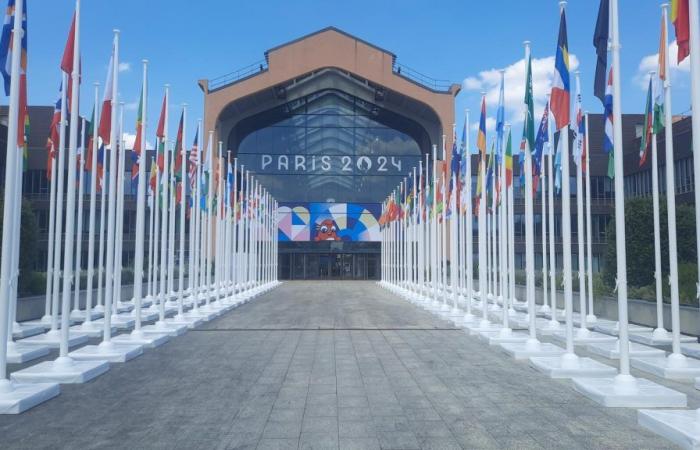Vincent Gibert
The main entrance to the Cité du Cinéma in Saint-Denis, converted into a restaurant for the athletes of the Olympic village, June 25, 2024.
PARIS JOYS – A bit like the « test events » Olympic sites – like the successful climbing one at Le Bourget this weekend – the athletes’ restaurant in the Olympic and Paralympic village held its own on Tuesday June 25 at lunchtime.
Located in the heart of the Cité du cinéma in Saint-Denis, where a good part of the installations were emptied for the occasion, the site adjoining the Olympic village is impressive. With its immense nave and glass roof, it will accommodate nearly 15,000 athletes over a little over a month and a half.
Vincent Gibert
Under the main nave in the athletes’ restaurant.
From its opening on July 18, a week before the opening ceremony of the Olympic Games, to the end of the Paralympic Games in September, it will simply be “the largest restaurant in the world” this summer, as the director of Paris 2024, Tony Estanguet, summarized to the press before a lunch bringing together 200 guests, including Olympic medalists Hélène Defrance (sailing) and Brice Guyart (fencing).
For the foilist, the test passed with flying colors. “What we have on the plate is perfect, well above Beijing, Rio or Athens. This also changes from the previous Olympics where we ate under large air-conditioned tents…”entrusted after the meal to HuffPost the fencer now aged 43.
It must be said that Paris 2024 did not do things by halves. In the grandiose setting of the Cité du cinéma, inaugurated a dozen years ago, athletes will be able to eat in six large patios with well-identified cuisines: French, Asian, African, Caribbean, etc.
Vincent Gibert
Patio N.1, the only one that will be open 24 hours a day during the Olympics and Paralympics.
No fries
Sodexo Live chefs, including Charles Guilloy and Stéphane Chicheri, have imagined no fewer than 500 hot dish recipes, of which 50 different ones will be available daily. On the menu, classic with grills, fish, pasta, pizzas, fruits and vegetables, salad bars… but no fries. The organization preferred to avoid any frying for ecological reasons.
One of the salad bars in the athletes’ restaurant.
The environmental issue remains a major concern of Paris 2024, with a main objective of halving single-use plastic compared to previous editions. This is why athletes will not find, for example, any plastic bottles in the entire Olympic village. Instead, they will be able to fill their water bottles or drink from reusable cups in one of the 200 water and soda fountains provided by Coca-Cola, historic sponsor of the Olympics.
The water and soda fountain on patio N.1.
The reusable cup which will be distributed in the athletes’ restaurant.
“On the plastic part, we went as far as possible”estimates Grégoire Béchu, food project manager for Paris-2024, with the HuffPost.
Emphasis is also placed on the fight against food waste, with associations and food banks which will come to collect any remaining consumable surplus every day.
3,300 seats
In the kitchen and in the dining room, 1,000 Sodexo employees will serve 40,000 meals per day, half of which will be vegetarian. Nearly 80% of the dishes cooked will be of French origin. Carrefour will deliver a total of 600 tonnes of fresh products and raw materials during the two competitions, which will be stored in 800 m² of cold rooms in the basement.
The seating capacity of the venue has been set at 3,300 seats, but athletes will also be able to eat in one of the six « grab and go » scattered throughout the Olympic Village. On the athletes’ restaurant site, no meals can be taken away, except for the injured and sick.
Finally, nutritionists will be present daily in the restaurant for athletes needing advice. If around 300 grams of food per meal is generally the norm for a person, the IOC specifications impose a quantity of 800 grams for athletes, which will therefore be the case this summer.
For Sodexo, the big challenge will ultimately remain managing the stocks and flows of food really needed on a daily basis during this intense period, with still some unknowns. “It is hard to predict what athletes will do, for example, once they are eliminated. Some will stay two or three more days, others will leave immediately…”thus slipped to HuffPost a collaborator of the group.
Also see on Le HuffPost :
Reading this content may result in cookies being placed by the third-party operator who hosts it. Taking into account the choices you have expressed regarding the deposit of cookies, we have blocked the display of this content. If you wish to access it, you must accept the “Third Party Content” category of cookies by clicking on the button below.
Play Video






